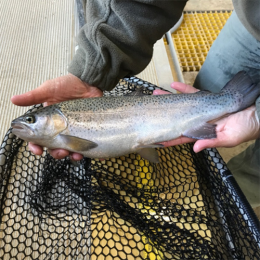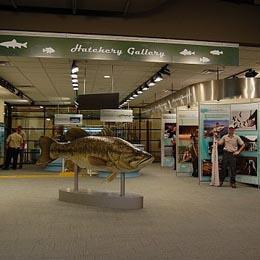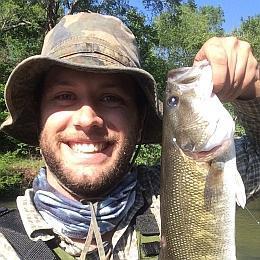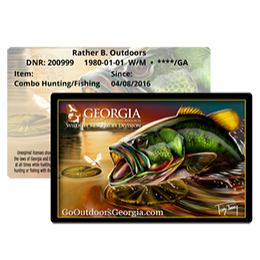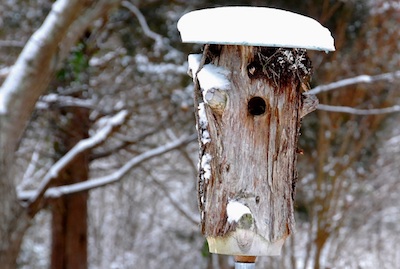
By Terry W. Johnson
If you are a homeowner, you know there are many tasks you need to complete before winter. These jobs range from raking leaves to splitting and stacking wood, checking the insulation around your doors and windows, planting wildflower seeds, winterizing faucets, and, well, you name it.
I would like you to think about adding another chore to your list: Consider putting up a nesting box or two in your yard. I'll bet you have never thought about erecting a bird box in November. This is a task most of us reserve for late winter or early spring. However, there is a very good reason why early November is an ideal time to put up a nesting box. That is, you will be providing bluebirds or other cavity-nesting birds with a safe, warm roosting site throughout the rest of the fall and winter.
Such sites can be extremely helpful to many birds, especially during winter’s coldest nights. On bitter nights, without access to tree cavities and manmade nesting/roosting structures, these birds can literally freeze to death before morning.
The long list of birds that use cavities as roosting sites includes screech owls, eastern bluebirds, nuthatches, downy woodpeckers, northern flickers, winter wrens and Carolina chickadees. Even blue jays, which do not nest in cavities, will seek shelter in nesting boxes when the going gets tough.
One of the first birds I ever saw using a cavity for a winter roost site was a Carolina chickadee. One winter the chickadee roosted each night in the uppermost pipe in my daughter's swing set.
Invariably there are never enough nesting or roosting sites for all of the cavity-nesting birds that nest in your area. That problem is compounded in winter when migrants from other parts of the country make their winter home in your neck of the woods, competing for the precious few winter roost sites available.
You can at least partially alleviate this issue by putting up additional nest boxes before winter.
Although cavity-nesting birds such as bluebirds, Carolina chickadees, tufted titmice and others will use nesting boxes as nighttime roost sites without modifications, there are a few things you can do to make these boxes cozier.
First, if you already have one or more boxes in your yard, inspect them and discard any droppings, dead birds, unhatched eggs, wasp nests and the like. You might even want to wash the interior of the box with a weak bleach solution. If you do, let the box thoroughly dry before putting it back up. These precautions will thwart the spread of disease.
Next, placing an inch or so of dry wood chips or dry grass in the bottom of the box will provide a bit of insulation. Some folks even go to the trouble of covering the bottom of a box with a piece of Styrofoam with a few drainage holes drilled in it. If you do decide to insulate a box with Styrofoam, however, make sure to remove it before the onset of nesting season.
The interior of the box also can be further insulated by plugging the box's vent holes with grass or other suitable material.
It is my feeling that such measures are not necessary throughout most of the state except during the harshest winters. I have never taken such measures and have never found dead birds in a box later.
One thing you might consider, though, is drilling a couple of holes opposite one another in the sides of the box. Then insert a wooden dowel through the holes to create a perch for birds using the box as a winter roost site. The dowels also should be removed before the beginning of the nesting season.
The dowels are great if a number of birds decide to roost in a box. I have seen several eastern bluebirds crowd into one of the boxes in my yard. Others report seeing 20 or more birds jam into the same box. Can you imagine 20 birds jockeying for a comfortable spot in the limited space found in the bottom of a typical bluebird box? Adding a perch or two goes a long way toward solving this problem.
When more than one bird roosts in a box, the heat generated by their bodies makes the inside of a box warmer than it would be when only one bird is occupying it.
One thing I rarely see in people's yards is a roosting box. This is a box with the entrance hole at the bottom of the box's front. Above the hole is a series of perches. The theory behind this design is that because warm air rises, a box loses less heat when the entrance hole is at the bottom.
There is at least one model of roosting box on the market which the manufacturer claims serves as both a nesting and a roosting box. This box opens in the front for easy cleaning. As such, at the end of the nesting season the front panel can be easily turned upside down, instantly transforming the box into a roosting box complete with a hole at the bottom.
If you don't want to go to the trouble of insulating a box, erect a log nesting structure. The thick walls of these dwellings provide more insulation that a box built of lumber.
If you are curious as to whether your boxes are doubling as winter roost sites, simply inspect them for signs of use. When birds roost in a nesting structure they often leave behind downy feathers, droppings or even seeds. A word of caution, however: Do not check a box at night. Birds disrupted during the night often stop using the box from then on.
Finally, before putting a box up place a metal hole guard around the entrance hole. This prevents squirrels from enlarging the hole and ruining the box. Keep in mind that they, too, are looking for “roost” sites. Whole guards are available in a variety of sizes and can be bought from stores that specialize in wild bird supplies.
I hope you agree that putting up a bird nest box in November is not such a bad idea after all!
Terry W. Johnson is a retired Nongame program manager with the Wildlife Resources Division and executive director of The Environmental Resources Network, or TERN, friends group of the division’s Nongame Conservation Section. (Permission is required to reprint this column.) Learn more about TERN, see previous “Out My Backdoor” columns, read Terry’s Backyard Wildlife Connection blog and check out his latest book, “A Journey of Discovery: Monroe County Outdoors.”
 An official website of the State of Georgia.
An official website of the State of Georgia.

